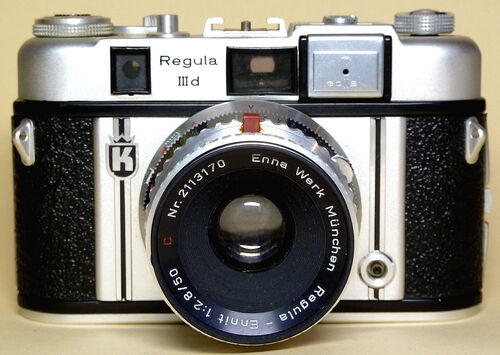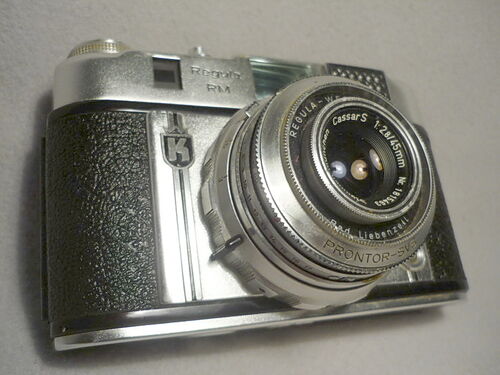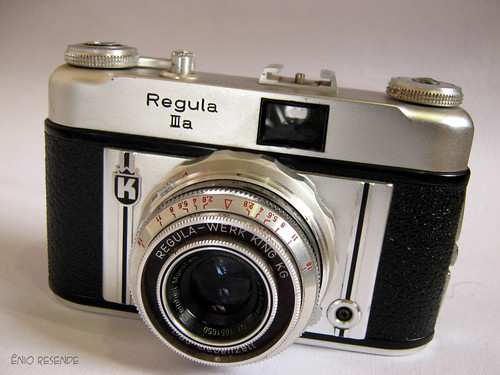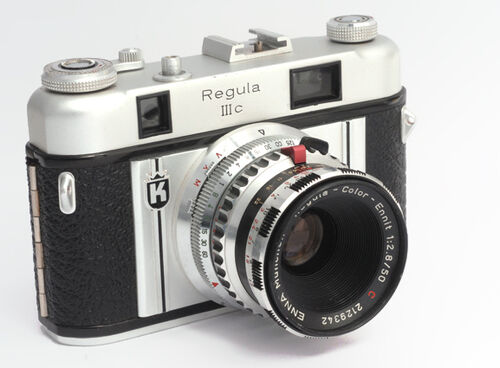History[]
A series of 35mm viewfinder and rangefinder cameras made by King as parts of the King Regula range between 1956-1959. The IIIa and IIIb are viewfinder cameras, the IIIc and IIId are coupled rangefinders with interchangeable lenses, the RM is a fixed lens version of the IIId. The IIIb, IIId and RM have selenium meters.
The III-series has a characteristic front plate. This is a flat rectangular Eloxal (ELectrolytic OXidation of ALuminum) plate, with distinctive chrome-black-chrome stripes each side. The King logo is at the top of the left-hand stripe, and a PC flash sync connector on the bottom right stripe. The other common things across the range are the film advance/film counter lever, the rear opening switch and having the model name stamped on the front of the camera.
Regula IIIa[]
| Regula IIIa |
|---|
| Manufacturer: King
Date of Production: 1956 Type of Camera: Viewfinder Film Type: 35mm Lens: Steinheil Cassar 45mm f/2.8 Shutter speed range: 1s-1/300th + Bulb Focus areas: 1m-Infinity Viewfinder: Yes |
The Regula IIIa is the most basic of the III series, a simple viewfinder with no bright lines and no light meter. It does have a full speed range Prontor-SVS shutter which is much better than older basic Regulas; the previous Regula II base model had a manually cocked shutter!
The IIIa was also redesigned and re-badged in 1958 as the Mastra V35 for Photopia in the UK.
Regula IIIb[]
| Regula IIIb |
|---|
| Manufacturer: King
Date of Production: 1956 Type of Camera: Viewfinder Film Type: 35mm Lens: Steinheil Cassar 45mm f/2.8 Shutter speed range: 1s-1/300th + Bulb Focus areas: 1m-Infinity Viewfinder: Yes |
It is similar to the IIIa but has Gossen uncoupled lightmeter, and bright lines in the viewfinder.
Regula IIIc[]
| Regula IIIc |
|---|
| Manufacturer: King
Date of Production: 1956 Type of Camera: Rangefinder Film Type: 35mm Shutter speed range: 1s-1/300th + Bulb Focus areas: 1m-Infinity Viewfinder: Yes |
The Regula IIIc is basically a IIId but with no light meter and long-base coupled rangefinder. It also has the same interchangeable lens system as the IIId.
Regula IIId[]
| Regula IIId |
|---|
 Manufacturer: King Date of Production: 1956 Type of Camera: Rangefinder
Film Type: 35mm Shutter speed range: 1s-1/300 + Bulb Focus areas: 1m-Infinity Viewfinder: Yes ASA/ISO range: 6-1600 Size (w*h*d): 130mm * 85mm * 85mm Weight: 690g (1.5lbs) |
This was the top of the range III series with a coupled rangefinder, uncoupled LV reading light meter (same one as the IIIb) and interchangeable lenses; unsure of what kind of lens mount it uses, two other lenses were made for it including a f/1.9 Enna lens; the lenses use 45mm filters. The light meter is made by Gossen and is under a metal flap to protect the selenium cell when not in use; it reads using the LV system, you then set the LV value on the aperture ring, it then limits the range of shutter speeds and apertures for that particular LV setting, almost like an LV priority mode. The rangefinder window is rather small with no bright lines or parallax correction like the IIIc. Using it is easier than the fixed lens Regula rangefinders (RM/Cita III) as the focusing ring is on the end of the lens rather than tight to the camera body with tiny plastic wedges.
The construction of the camera is nearly all metal, the only plastic pieces being trim around windows, the film take up and stuck on leatherette; this makes the camera quite heavy for a compact rangefinder, it weighs in at 690 grams (1.5 pounds). The film counter on the film advance lever has a reliability issue, it relies on a tiny rod in the film advance lever and a fixed rod on the camera pushing against each other every time the lever is advanced to increase the count by one; the problem is the rods are so small that they wear down with repeated use until the film counter stops working.
Regula Cita III[]
| Regula Cita III |
|---|
 Manufacturer: King
Date of Production: 1956
Type of Camera: Rangefinder
Film Type: 35mm
Lens: Steinheil Cassar 45mm f/2.8
Shutter speed range: 1s-1/300 + Bulb
Focus areas: 1m-Infinity
Viewfinder: Yes
ASA/ISO range: 10-3200
Size (w*h*d): 130mm * 85mm * 70mm |
The Cita III was the fixed lens version of the IIId. This means it shares a lot of similar functions and the construction of the camera is the same being nearly all metal, the only plastic pieces being trim around windows, the film take up, stuck on leatherette and light meter scale. It has coupled rangefinder and Gossen uncoupled light meter. The meter reads in LV scale; the lens has LV priority style shutter/aperture system, the aperture does lack the f/22 setting of the IIId though. The rangefinder control is the same as the Cita camera where the focus ring is mounted behind everything next to the camera body. This makes using it quite awkward as at either end of the focus scale (1m or inf) as your fingers tend to block either the viewfinder or rangefinder windows. The view/rangefinder in the Cita III is the same as the IIId with a small circular focus spot and no frame markings.
Regula RM[]
| Regula RM |
|---|
 Manufacturer: King Date of Production: 1956 Type of Camera: Rangefinder Film Type: 35mm Lens: Zeiss Tessar 50mm f/2.8 Shutter speed range: 1s-1/300 + Bulb Focus areas: 1m-Infinity Viewfinder: Yes ASA/ISO range: 10-3200 Size (w*h*d): 130mm * 85mm * 70mm Weight: 570g |
The Regula RM is one of the last of the III series range despite not having III in it's name. The Cita III was the fixed lens version of the IIId, it was introduced first; later on the RM was introduced. The first version of the RM is basically identical to the Cita III, the second version has a Bewi uncoupled light meter not the same Gossen meter as the IIId; the second version of the RM eventually replaced the Cita III. According to Helen Smith in her Irregular Regulas article there is also a RM fitted with a Enna Ennalyt 45mm f/1.9 lens rather than the standard Zeiss Tessar 50mm f/2.8.
The camera is basically a fixed lens IIId so shares a lot of similar functions and the construction of the camera is the same being nearly all metal, the only plastic pieces being trim around windows, the film take up, stuck on leatherette and light meter scale. It has coupled rangefinder and Bewi uncoupled light meter that works with a red button on the top of the camera, the meter reads in LV scale; the lens has LV priority style shutter/aperture system, the aperture does lack the f/22 setting of the IIId though. The rangefinder control is the same as the Cita/Cita III cameras where the focus ring is mounted behind everything next to the camera body; this makes using it quite awkward as at either end of the focus scale (1m or inf) your fingers tend to block either the viewfinder or rangefinder windows. The view/rangefinder in the RM is bigger and better than the IIId as it has view lines with parallax corrections marks; the rangefinder overlay is also much clearer than the IIId as it is bigger and rectangular rather than round.
Links[]
- Irregular Regulas by Helen Smith (great article which this page borrows heavily from).
in French:


